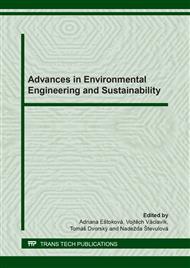[1]
G. Elvin, Nanotechnology for Green Building, Green Technology Forum, (2007). Available online: http://esonn.fr/esonn2010/xlectures/mangematin/Nano_Green_Building55ex.pdf.
Google Scholar
[2]
P. Smith, Architecture in a Climate of Change: A Guide to Sustainable Design, Oxford: Architectural Press, (2005).
Google Scholar
[3]
United Nations Environmental Programme Buildings and Climate Change, (2014). Available online: http://www.unep.org/Documents.
Google Scholar
[4]
European Union Regulation (EC) No. 761/2001 of the European Parliament and of the Council of 19 March 2001 allowing voluntary participation by organizations in a community eco-management and audit scheme (EMAS), (2001). Available online: http://ew.eea.europa.eu/ ManagementConcepts/EMAS/emas_en.pdf Access.
DOI: 10.1007/1-4020-3492-x_6
Google Scholar
[5]
P. Skřehot, M. Rupová, Nanobezpečnost Praha: Výzkumný ústav bezpečnosti práce, ISBN 978-80-86973-89-0.
Google Scholar
[6]
F. Pacheco-Torgal, R. Miraldo, Y. Ding, J.A. Labrincha, Targeting HPC with the help of nanoparticles, Construction and Building Materials, (2015), vol. 38, pp.365-370.
DOI: 10.1016/j.conbuildmat.2012.08.013
Google Scholar
[7]
K. Sobolev, F. Sanchez, S. Flores, The use of nanoparticle admixtures to improve the performance of concrete, 12th International 84 Conference on Recent, Advances in Concrete Technology and Sustainability, (2012),. 455-469.
Google Scholar
[8]
C. Lee, X.D. Wei, J.W. Krysar, J. Hone, Measurement of the elastic properties and intrinsic strength of monolayer graphene, Science, (2008), vol. 32,. 385-388.
DOI: 10.1126/science.1157996
Google Scholar
[9]
K.G. Dassios, P. Alafogianni, S. Antiohos, CH. Leptokaridis, N.M. Barkoula, T. Matikas, Optimization of Sonication Par ameters for Homogeneous Surfactant-Assisted Dispersion of Multiwalled Carbon Nanotubes in Aqueous Solutions, The J. of Phys. Chem., 2015,. 7506-7516.
DOI: 10.1021/acs.jpcc.5b01349
Google Scholar
[10]
K.M. Liew, M.F. Kai, L.W. Zhang, Mechanical and damping properties of CNT-reinforced cementitious composites, Composite Structures. ISSN 02638223, 2017,. 81-88.
DOI: 10.1016/j.compstruct.2016.10.043
Google Scholar
[11]
R. Siddique, M. Ankur, Effect of carbon nanotubes on properties of cement mortars, Construction and Building Materials, (2014), vol. 50. 116-129.
DOI: 10.1016/j.conbuildmat.2013.09.019
Google Scholar
[12]
R. Hamzaoui, A. Bennabi, S. Guessasma, R. Khelifa, N. Leklou, Optimal Carbon Nanotubes Concentration Incorporated in Mortar and Concrete, Advanced Materials Research, ISSN 1662-8985, (2012),. 107-110.
DOI: 10.4028/www.scientific.net/amr.587.107
Google Scholar
[13]
K. Pacltová, The issue of the use of carbon nanotubec in cement composities. Bachelor´s thesis, Brno University of Technology, Supervisor Doc. Ing. Lenka Bodnárová, Ph.D.
Google Scholar
[14]
K. Hrabová, Nanomaterials in the construction industry, Junior Forensic Science Brno, Brno University of Technology, Institute of Forensic Engineering, (2018), ISBN: 978-80-214-5621-1. 179-184.
Google Scholar
[15]
A. Nemmar, M.F. Hoylaerts, P.H. Hoet, D. Dinsdale, T. Smith, H. Xu, Ultrafine particles affect experimental thrombosis in an in vivo hamster model. Am J Respir Crit Care Med, (2018),. 998–1004.
DOI: 10.1164/rccm.200110-026oc
Google Scholar
[16]
K. Hrabová, Carbon nanotubes, Expert Forensic Science Brno, Brno University of Technology, Institute of Forensic Engineering, (2019), ISBN: 978-80-214-5708-9. 322-329.
Google Scholar
[17]
A. Cwirzen, K. Habermehl-Cwirzen, V. Penttala. Surface decoration of carbon nanotubes and mechanical properties of cement/carbon nanotube composites. Advanced in Cement Research (2008), Vol. 20,. 65-73.
DOI: 10.1680/adcr.2008.20.2.65
Google Scholar
[18]
F. Collins, J. Lamberz, W.H. Duan, The influences of admixtures on the dispersion, workability, and strength of carbon nanotube – OPC paste mixtures, Cement and concrete composites. Elsevier, (2012), Vol. 34, Issue 2,. 201-207.
DOI: 10.1016/j.cemconcomp.2011.09.013
Google Scholar


